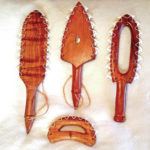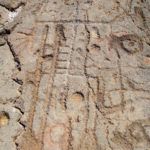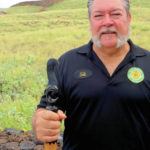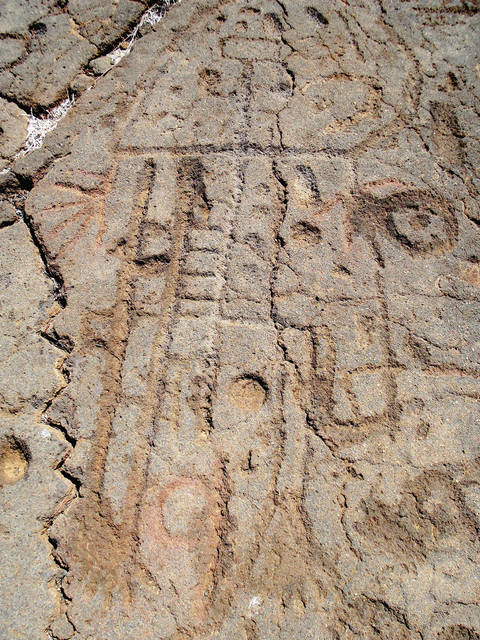More than meets the eye: Delving deeper into the Hawaiian culture



KOHALA — To Ski Kwiatkowski, petroglyphs, tattoos and carvings all have one thing in common.
“It’s the culture,” he said. “To understand the Hawaiian culture, you’ve got to immerse yourself in it.”
Appointed Alii ‘Aimoku for The Royal Order of Kamehameha I Moku O Kohala last July, Kwiatkowski can trace his genealogy back 73 generations to Tahiti. His family’s last four generations have lived in Waimea and Kohala.
“My great-great-grandmother and great-great-grandfather were married in Waimea in 1852, and my great-grandmother was born here in 1856,” Kwiatkowski said, who is one-quarter Hawaiian, one-quarter Portuguese and one-half Polish. “The other side of the family were from Kohala.”
Established April 11, 1865, by King Kamehameha V to honor the legacy of his grandfather, The Royal Order was reorganized by Prince Jonah Kuhio Kalanianaole in 1902. Moku O Kohala was formed on Hawaii Island in 1962, with 34 members today ranging in age from their 30s to 80s.
“The Royal Order is based on moral character and the desire to help others. Our priorities are to preserve our culture and historic sites, and to monitor development that might impact them,” Kwiatkowski said.
There are now 10 chapters statewide, with the most recent formed in Puna last year.
“We have a lot of commitments in the community and state. For members, it’s not what the Order is going to do for them, but what they’re going to do for the community,” he said.
To share the region’s rich history, Moku O Kohala members can often be found at Pu’ukohola Heiau in Kawaihae, where they host two free cultural presentations monthly on topics such as Prince Jonah Kuhio Kalanianaole, the value of the hala leaf for weaving and the beautiful sounds that come from the ukulele.
To do so, members bring a wealth of experience from varied backgrounds.
“Moku O Kohala’s district includes Waimea, Waikoloa and Kohala using the ancient land boundaries,” Kwiatkowski said. “Our members include educators, doctors, lawyers, artists, fashion designers or retired. We also have honorary members, such as Earl Bakken and most recently Dr. Franco Acquaro from Kipuka o ke Ola (KOKO). They work with us to advance our specific focuses.”
Education and health are two of the chapter’s focuses.
“We partner with KOKO to help improve health in our community. We direct people to them and support them by volunteering and contributing to their fundraisers,” Kwiatkowski said.
The chapter also gives away between 12 and 15 $1,000 scholarships to students each year — not limited just to Hawaiians. This year’s annual scholarship fundraiser is slated for June 16 at Kahilu Town Hall.
“Just this past semester five people graduated that we have been supporting for four years, and four others made the dean’s list,” he said. “We would like to raise more than $30,000 annually to have an endowment. We’re in it for the long haul.”
One of The Royal Order’s main goals is to one day restore the Hawaiian government. In 1995, the Order issued a proclamation stating that the Kingdom of Hawaii still exists.
“Re-establishing the Hawaiian government will be in whatever way, shape or form the people of that government decide,” Kwiatkowski said. “It could be a coalition of many groups to form a functioning government — all in one canoe. It could be anyone whose ancestor was here 1893 — Chinese, Japanese, Portuguese, haoles — automatically a naturalized citizen of the Hawaiian Kingdom.”
Discovering petroglyphs
Petroglyphs and the art of traditional Hawaiian tattooing have fascinated Kwiatkowski from an early age. After extensive research, he wrote books on both topics that were first printed in the 1990s.
“I have studied petroglyphs since I was five years old. I discover new ones all the time. When I find new petroglyphs I do research on them and find out that no one has seen these things or recorded them,” he said.
According to Kwiatkowski’s calculations, the triangular body figure was developed in Hawaii and Tonga at the same time — around 1300 A.D.
Depending on the location, petroglyphs can serve different purposes: some religious, others as birth records. Figuring out what they mean can take significant time and effort.
“You can’t look at them for meaning unless you speak Hawaiian,” Kwiatkowski said. “But even if you speak Hawaiian, only if you think deeper will you come up with a second meaning which is probably what was intended by the maker.”
He had an epiphany at the Waikoloa petroglyph field one day while looking at a massive conglomerate that started with one stick figure.
“Other figures were added over the years by family members, generations later. I saw an arch from shoulder to shoulder on one that signified a rainbow for a very high chief,” Kwiatkowski explained. “But it was only by speaking the language out loud that I figured out the spikes on the side meant ‘wearing a feather cape.’ They didn’t draw the cape on the figure, but by placing the spikes there, anyone thinking in Hawaiian could figure it out.”
The petroglyphs’ purpose is to record history, but there was a steep decline just before Captain Cook came to Hawaii, he said.
“After the arrival of Cook, they take on another style that’s not Hawaiian at all, kind of a post-contact style. When Hawaiians learned how to read and write they started to do profile petroglyphs,” Kwiatkowski remarked.
He has been leading private petroglyph educational tours for societies, organizations and one off-island school for decades.
“We want them to get more out of being here than just a white sand beach,” Kwiatkowski said. “I would love every person that comes to visit Hawaii to come away feeling there’s more to this than meets the eye.”
He said there are literally 100 locations where petroglyphs can be found on the island, but most are difficult to access and should be protected.
“Isolation is their only friend,” Kwiatkowski said.
He is uncertain how this knowledge of the petroglyphs will be carried on.
“Nobody has ever asked me to teach them how to teach others. What I know is about 15 or 20 percent of what the petroglyphs really mean because the other 80 percent nobody knows. If all I can pass on is 20 percent, they would have a pretty good idea of what they’re looking at,” Kwiatkowski said.
The art of carving
In addition to crafting wooden furniture, another of his talents is carving daggers and spears. His favorite materials are koaia wood, found only in Kohala, and sharks teeth.
“The first spear I ever carved, when I was 25 years old, took about a month to make,” Kwiatkowski said. “I didn’t realize the complexity. It gave me a new respect for people who worked with Stone Age tools, since I was using metal tools.”
After researching methods, woods and techniques at Bishop Museum, he has taught The Royal Order members how to make a variety of items including clubs and daggers.
“Now they have their own individual weapons and there’s a pride in being able to do that. This is also a part of The Royal Order — sharing things valuable to our culture with each other. I do it because I like to do it. I think of making weapons as ‘soul work,’” he added.
A student of tattoos
“Authentic Hawaiian tattoos tell stories deeper than the eye can see,” Kwiatkowski said.
A tattoo artist for many years, he uses boars’ tusks to make his own tattoo needles to tattoo himself.
“Decorating the body by tattooing is an ancient practice in many areas of the world. In some part of Polynesia that art developed to its highest degree. The very word tattoo is of Tahitian origin — tatau. The Hawaiian word is kakau,” he said in the foreword of his book, “The Hawaiian Tattoo.”
Kwiatkowski goes on to outline the history of tattooing, techniques and terminology, and tattoo designs — some geometric, some related to the aumakua or a family or personal god — and others worn for fanciful decoration, grief or marks of shame.
“Upon the arrival of the American missionaries in the 1820s, the practice of tattooing was frowned upon,” he said. “The same designs that occur in tattooing, that occur in petroglyphs, that occur on tapa have the same name so the art forms had a common thread. They weren’t independent of each other. The same general design bounced through all of those arts and disciplines before pre-dated contact.”
Kwiatkowski most wants to be remembered for his involvement in the entire community, not just the Hawaiian community.
“My association with The Royal Order has commanded me to get involved. Long after I’m gone they’re gonna say, ‘I remember this guy, Ski, who used to take me out on the trails to see petroglyphs,” he concluded.
Info: The Royal Order Moku o Kohala’s next free cultural demonstration at Pu’ukohola Heiau will focus on the ukulele from 9 a.m.-1 p.m. this Friday. For details on other presentations call 882-7218.





Aloha Ski…great great story…….can I order a walking stick from you?..I am on Konaweb..can be contacted there..mahalo